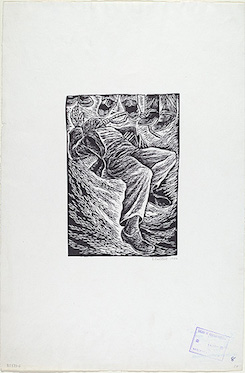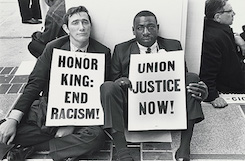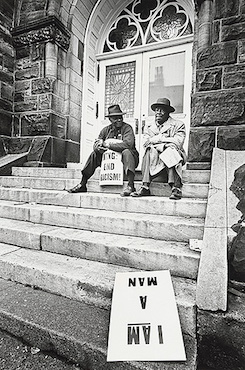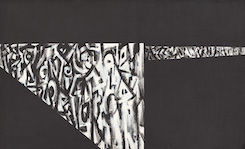
Danny Lyon, Magnum Photos, John Lewis and Colleagues, Prayer Demonstration at a Segregated Swimming Pool, Cairo, Illinois, 1962, printed 1969, gelatin silver print, Corcoran Collection (Museum Purchase), 2015.19.4466
What role did artists and artwork play in the civil rights movement?
What role did young people play in the civil rights movement?
How does the civil rights movement relate to today’s struggles for freedom and equality?
“[These images] are a testament to the ability of a committed, determined people to transform a nation, even the most powerful nation on earth, and bring it more in line with the call for justice.” —Congressman John Lewis
In 1962 photographer Danny Lyon captured three young African Americans protesting through prayer in front of a “whites-only” swimming pool and recreational facility in Cairo, Illinois. Their demonstration was part of a larger effort to integrate businesses and other spaces in the town. Lyon was involved in the movement and developed strong relationships with members of the Student Nonviolent Coordinating Committee (SNCC), a group of young people who were committed to full-time grassroots organization. Through his involvement, Lyon captured many aspects of SNCC’s efforts, from prayer demonstrations led by a young John Lewis (at left) to violence suffered by students at the hands of the National Guard. John Lewis continued his activism for many years and was elected to the US Congress in 1986, where he continues to serve as a representative for Georgia in the House of Representatives.
SNCC used this 1962 photograph to develop its public image in support of expanded rights for African Americans. For example, it was used as part of a poster series; printed in bold below the demonstrators’ photograph were the words “come let us build a new world together.”
SNCC and other community groups organized for the right to equal access to public facilities, the right to vote, and the right to equal employment. However, these ideas needed a higher profile in order to gain popular support. Recognizing the recent and widespread use of photographs in the news, grassroots organizers and community leaders worked with photographers to craft compelling stories and evoke a sense of urgency in the greater American populace. Benedict J. Fernandez, another prominent photographer of the civil rights era, documented the life of Dr. Martin Luther King Jr. as well as the activists around him. Fernandez followed King in the last few years of his life, photographing both his family and public life. His photographs help us see the larger community around King, highlighting his allies, young marchers, large crowds at rallies, and the everyday realities of life at that time.
Through their work, artists of the civil rights era captured and communicated a people’s movement—a movement of ordinary people, many of whom were young, who came together to expand rights for all. Images created by Lyon, Fernandez, and many other artists played a pivotal role in shaping the public’s understanding of the civil rights movement and inspiring citizens to action.
Today, photographers continue to pick up their cameras to highlight injustices. Artist Dawoud Bey’s Birmingham Project, which focuses on the legacy of the 16th Street Baptist Church bombing in 1963, asks viewers to reflect on how the past impacts the present. Images like Bey’s force viewers to consider the ongoing legacy of the civil rights movement—using insights from the past, specifically those captured in photographs, to help us more fully understand the struggles for freedom and equality today.















